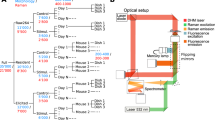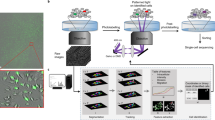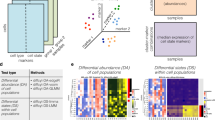Abstract
Microscopy often reveals the existence of phenotypically distinct cellular subpopulations. However, additional characterization of observed subpopulations can be limited by the number of biomolecular markers that can be simultaneously monitored. Here we present a computational approach for extensibly profiling cellular subpopulations by freeing one or more imaging channels to monitor additional probes. In our approach, we trained classifiers to re-identify subpopulations accurately based on an enhanced collection of phenotypic features extracted from only a subset of the original markers. Then we constructed subpopulation profiles step-wise from replicate experiments, in which cells were labeled with different but overlapping marker sets. We applied our approach to identify molecular differences among subpopulations and to identify functional groupings of markers, in populations of differentiating mouse preadipocytes, polarizing human neutrophil-like cells and dividing human cancer cells.
This is a preview of subscription content, access via your institution
Access options
Subscribe to this journal
Receive 12 print issues and online access
$259.00 per year
only $21.58 per issue
Buy this article
- Purchase on Springer Link
- Instant access to full article PDF
Prices may be subject to local taxes which are calculated during checkout






Similar content being viewed by others
References
Gallin, J.I. Human neutrophil heterogeneity exists, but is it meaningful? Blood 63, 977–983 (1984).
Loo, L.H. et al. Heterogeneity in the physiological states and pharmacological responses of differentiating 3T3–L1 preadipocytes. J. Cell Biol. (in the press).
Rubin, H. The significance of biological heterogeneity. Cancer Metastasis Rev. 9, 1–20 (1990).
Chang, H.H., Hemberg, M., Barahona, M., Ingber, D.E. & Huang, S. Transcriptome-wide noise controls lineage choice in mammalian progenitor cells. Nature 453, 544–547 (2008).
Slack, M.D., Martinez, E.D., Wu, L.F. & Altschuler, S.J. Characterizing heterogeneous cellular responses to perturbations. Proc. Natl. Acad. Sci. USA 105, 19306–19311 (2008).
Lee, T.I. et al. Transcriptional regulatory networks in Saccharomyces cerevisiae. Science 298, 799–804 (2002).
Malik, Z., Dishi, M. & Garini, Y. Fourier transform multipixel spectroscopy and spectral imaging of protoporphyrin in single melanoma cells. Photochem. Photobiol. 63, 608–614 (1996).
Resch-Genger, U., Grabolle, M., Cavaliere-Jaricot, S., Nitschke, R. & Nann, T. Quantum dots versus organic dyes as fluorescent labels. Nat. Methods 5, 763–775 (2008).
Tsurui, H. et al. Seven-color fluorescence imaging of tissue samples based on Fourier spectroscopy and singular value decomposition. J. Histochem. Cytochem. 48, 653–662 (2000).
Boland, M.V. & Murphy, R.F. After sequencing: quantitative analysis of protein localization. IEEE Eng. Med. Biol. Mag. 18, 115–119 (1999).
Loo, L.H., Wu, L.F. & Altschuler, S.J. Image-based multivariate profiling of drug responses from single cells. Nat. Methods 4, 445–453 (2007).
Perlman, Z.E. et al. Multidimensional drug profiling by automated microscopy. Science 306, 1194–1198 (2004).
Rosen, E.D. & MacDougald, O.A. Adipocyte differentiation from the inside out. Nat. Rev. Mol. Cell Biol. 7, 885–896 (2006).
Weiner, O.D. Regulation of cell polarity during eukaryotic chemotaxis: the chemotactic compass. Curr. Opin. Cell Biol. 14, 196–202 (2002).
Yin, Z. et al. Using iterative cluster merging with improved gap statistics to perform online phenotype discovery in the context of high-throughput RNAi screens. BMC Bioinformatics 9, 264 (2008).
Cristianini, N. & Shawe-Taylor, J. An introduction to support vector machines: and other kernel-based learning methods. (Cambridge University Press, New York, 2000).
Pudil, P., Novovicová, J. & Kittler, J. Floating search methods in feature selection. Pattern Recognit. Lett. 15, 1119–1125 (1994).
Brasaemle, D.L. Thematic review series: adipocyte biology. The perilipin family of structural lipid droplet proteins: stabilization of lipid droplets and control of lipolysis. J. Lipid Res. 48, 2547–2559 (2007).
Weiner, O.D., Marganski, W.A., Wu, L.F., Altschuler, S.J. & Kirschner, M.W. An actin-based wave generator organizes cell motility. PLoS Biol. 5, e221 (2007).
Eden, S., Rohatgi, R., Podtelejnikov, A.V., Mann, M. & Kirschner, M.W. Mechanism of regulation of WAVE1-induced actin nucleation by Rac1 and Nck. Nature 418, 790–793 (2002).
Gratzner, H.G. Monoclonal antibody to 5-bromo- and 5-iododeoxyuridine: a new reagent for detection of DNA replication. Science 218, 474–475 (1982).
Goto, H. et al. Identification of a novel phosphorylation site on histone H3 coupled with mitotic chromosome condensation. J. Biol. Chem. 274, 25543–25549 (1999).
Darzynkiewicz, Z., Bedner, E. & Smolewski, P. Flow cytometry in analysis of cell cycle and apoptosis. Semin. Hematol. 38, 179–193 (2001).
Dolbeare, F., Gratzner, H., Pallavicini, M.G. & Gray, J.W. Flow cytometric measurement of total DNA content and incorporated bromodeoxyuridine. Proc. Natl. Acad. Sci. USA 80, 5573–5577 (1983).
Mittnacht, S. Control of pRB phosphorylation. Curr. Opin. Genet. Dev. 8, 21–27 (1998).
Pines, J. & Hunter, T. Human cyclins A and B1 are differentially located in the cell and undergo cell cycle-dependent nuclear transport. J. Cell Biol. 115, 1–17 (1991).
Dulic, V., Stein, G.H., Far, D.F. & Reed, S.I. Nuclear accumulation of p21Cip1 at the onset of mitosis: a role at the G2/M-phase transition. Mol. Cell. Biol. 18, 546–557 (1998).
Whitfield, M.L. et al. Identification of genes periodically expressed in the human cell cycle and their expression in tumors. Mol. Biol. Cell 13, 1977–2000 (2002).
Engelman, J.A. et al. Constitutively active mitogen-activated protein kinase kinase 6 (MKK6) or salicylate induces spontaneous 3T3–L1 adipogenesis. J. Biol. Chem. 274, 35630–35638 (1999).
Sadowski, H.B., Wheeler, T.T. & Young, D.A. Gene expression during 3T3–L1 adipocyte differentiation. Characterization of initial responses to the inducing agents and changes during commitment to differentiation. J. Biol. Chem. 267, 4722–4731 (1992).
Acknowledgements
We thank all members of the Altschuler and Wu lab at the University of Texas Southwestern Medical Center for critical discussion and for performing manual cell categorization; P.E. Scherer (University of Texas Southwestern Medical Center) and O.D. Weiner (University of California, San Francisco) for the gifts of the adiponectin and Hem1 antibodies, respectively; J. Rhorer at BD Biosciences for the gift of the cell cycle kit; and S.A. Kliewer, D.J. Mangelsdorf, J. Repa P.E. Scherer and H.T. Yu for stimulating conversations. This work was funded by the US National Institutes of Health (R01 GM081549 to L.F.W. and R01 GM085442 to S.J.A.), the Welch Foundation (I-1619 and I-1644 to L.F.W. and S.J.A.), the Rita Allen Foundation (S.J.A.) and the University of Texas Southwestern Endowment for Scholars in Biomedical Research (to L.F.W. and to S.J.A.). S.J.A. is a Rita Allen Scholar.
Author information
Authors and Affiliations
Contributions
L.-H.L. designed the profiling methods and performed the analysis. L.-H.L. and H.-J.L. performed the 3T3-L1 experiments. R.J.S. performed the H460 experiments. Y.W. performed the HL-60 experiments. L.H.L., L.F.W. and S.J.A. contributed to the conception of the overall approach, statistical analysis of the methods and writing of the manuscript.
Corresponding authors
Supplementary information
Supplementary Text and Figures
Supplementary Figures 1–8 and Supplementary Methods (PDF 1299 kb)
Supplementary Data
High-content feature list (XLS 221 kb)
Rights and permissions
About this article
Cite this article
Loo, LH., Lin, HJ., Steininger, R. et al. An approach for extensibly profiling the molecular states of cellular subpopulations. Nat Methods 6, 759–765 (2009). https://doi.org/10.1038/nmeth.1375
Received:
Accepted:
Published:
Issue Date:
DOI: https://doi.org/10.1038/nmeth.1375
This article is cited by
-
A statistical framework for high-content phenotypic profiling using cellular feature distributions
Communications Biology (2022)
-
Single-cell lipidomics with high structural specificity by mass spectrometry
Nature Communications (2021)
-
Optimum concentration–response curve metrics for supervised selection of discriminative cellular phenotypic endpoints for chemical hazard assessment
Archives of Toxicology (2020)
-
Capturing single-cell heterogeneity via data fusion improves image-based profiling
Nature Communications (2019)
-
Cell Painting, a high-content image-based assay for morphological profiling using multiplexed fluorescent dyes
Nature Protocols (2016)



